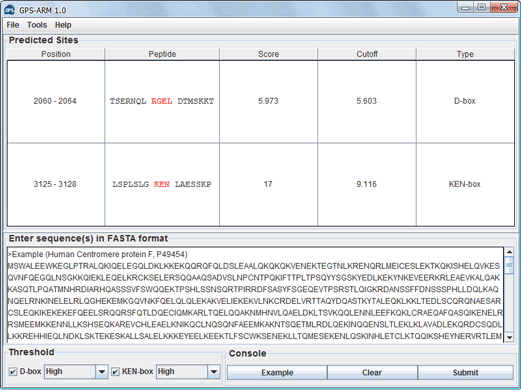※ GPS-ARM INTRODUCTION:
The 2001 Noble Prize in Physiology or Medicine was awarded to Leland Hartwell, Paul Nurse and Timothy Hunt for their seminal discoveries of key regulators of cyclin-dependent kinases (CDKs) in cell cycle and proliferation
(Nature Cell Biology, 2001;
Nasmyth et al, 2001).
Besides CDK-mediated phosphorylation, cell cycle proteins can also be precisely modulated by other mechanisms, such as ubiquitin-dependent degradation, mainly mediated by the Skp1-cullin-F box (SCF) and the APC/C
(Barford et al, 2011; Thornton et al, 2006; Peters et al, 2006; Fang et al, 1999;
Pagano et al, 1997;
Peters et al, 1998).
As a high-molecular-mass complex composed of 13 core subunits
(Barford et al, 2011;
Peters et al, 2006),
APC/C was firstly identified as an E3 ligase for the degradation of mitotic cyclins
(Sudakin et al, 1995).
Beyond mitosis, APC/C-mediated degradation also plays an important role in regulating Rho GTPase activity
(Liot et al, 2011;
Naoe et al, 2010), axon growth
(Kim et al, 2007),
cell adhesion
(Silies et al, 2010)
and glycolysis
(Tudzarova et al, 2011;
Colombo et al, 2010)
. In this regard, identification of APC/C-specific degradation substrates is fundamental for understanding the molecular mechanisms and regulatory roles of APC/C.
In 1991, Glotzer et al. firstly characterized an ennea-peptide (9aa) located at the N-terminus of cyclin B is responsible for its degradation during the mitotic exit (Glotzer et al, 1991). Further analyses revealed that the destruction box or D-box follows a minimal consensus of RXXL (where X is any amino acid), while two co-activators of APC/C, such as Cdh1 and Cdc20, can directly target and interact with the D-box (Owens et al, 2005; King et al, 1996; King et al, 1996). Recently, a structural analysis observed that a core APC/C subunit of Apc10 can also interact with the D-box and contribute recognition specificity together with Cdh1 (da Fonseca et al, 2011). A second APC/C degron, the KEN-box motif with consensus of KEN, can be recognized by Cdh1 and Cdc20 (Gurden et al, 2010; Pfleger et al, 2000). Although a number of non-canonical destruction signals were experimentally identified, such as the A-box (QRVL) of Aurora-B kinase (Nguyen et al, 2005), the GXEN motif in Xenopus chromokinesin Kid (Xkid) (Castro et al, 2003), the CRY-box in mammalian Cdc20 (Reis et al, 2006) and so on, the D-box and the KEN-box are regarded as the major APC/C recognition motifs (Barford et al, 2011; Thornton et al, 2006; Peters et al, 2006; Fang et al, 1999; Pfleger et al, 2001).
In this work, we manually collected all experimentally indentified D-box or KEN-box proteins from scientific literature. A previously self-developed GPS (Group-based Prediction System) algorithm was employed with great improvement. We calculated the leave-one-out validation and 4-, 6-, 8-, 10-fold cross-validations to evaluate the prediction performance and system robustness. The leave-one-out validation result for KEN boxes recognized by Cdh1 is accuracy (Ac) of 95.00%, sensitivity (Sn) of 93.18%, and specificity (Sp) of 100.00%, while for D-boxes recognized by Cdc20 is 87.29% (Ac), 63.51% (Sn), and 95.39% (Sp). The online service and stand-alone packages of GPS-ARM 1.0 were implemented in JAVA 1.6 and freely available at: http://arm.biocuckoo.org/.
GPS-ARM 1.0 User Interface

For publication of results please cite the following article:  GPS-ARM: computational analysis of APC/C recognition motif
GPS-ARM: computational analysis of APC/C recognition motifby predicting D-boxes and KEN-boxes Zexian Liu, Fang Yuan, Jian Ren, Jun Cao, Yanhong Zhou, Qing Yang and Yu Xue. |



